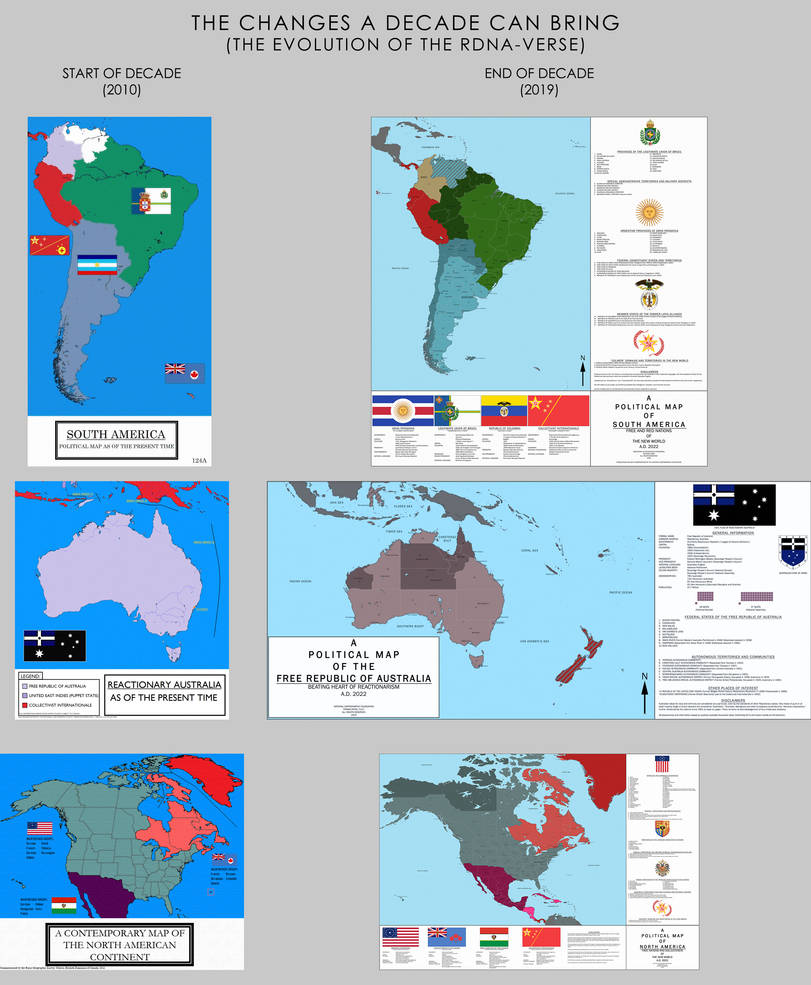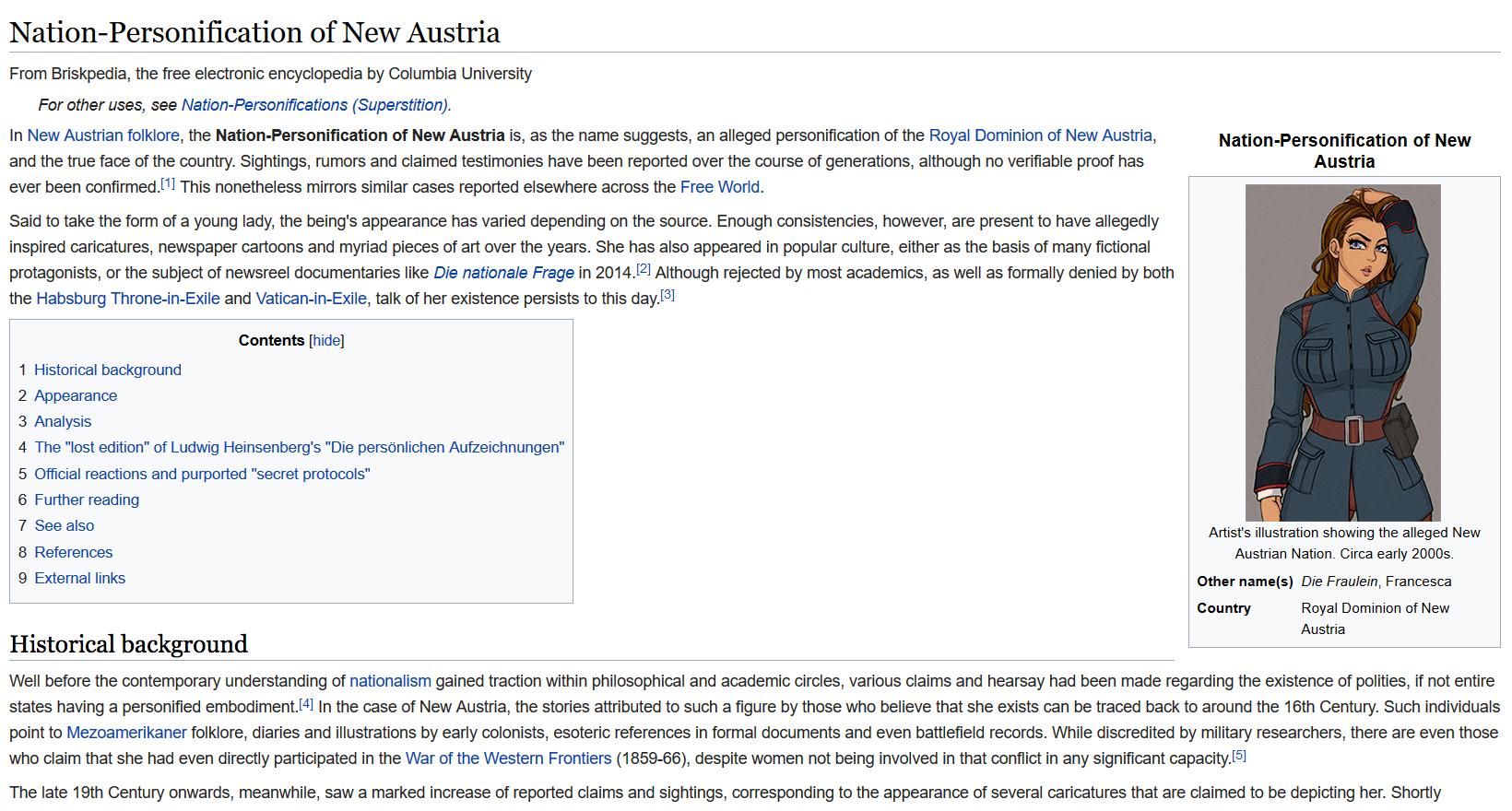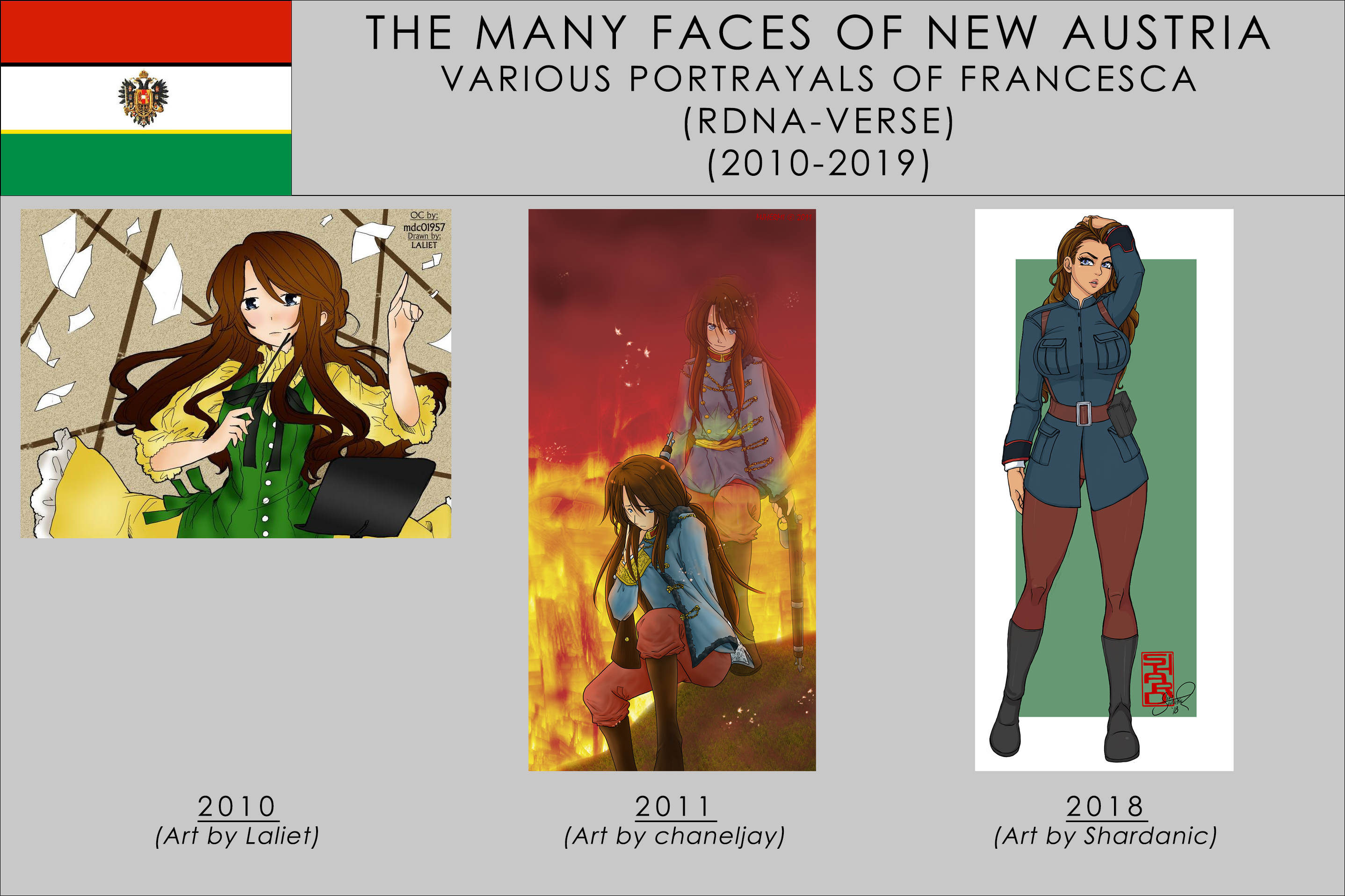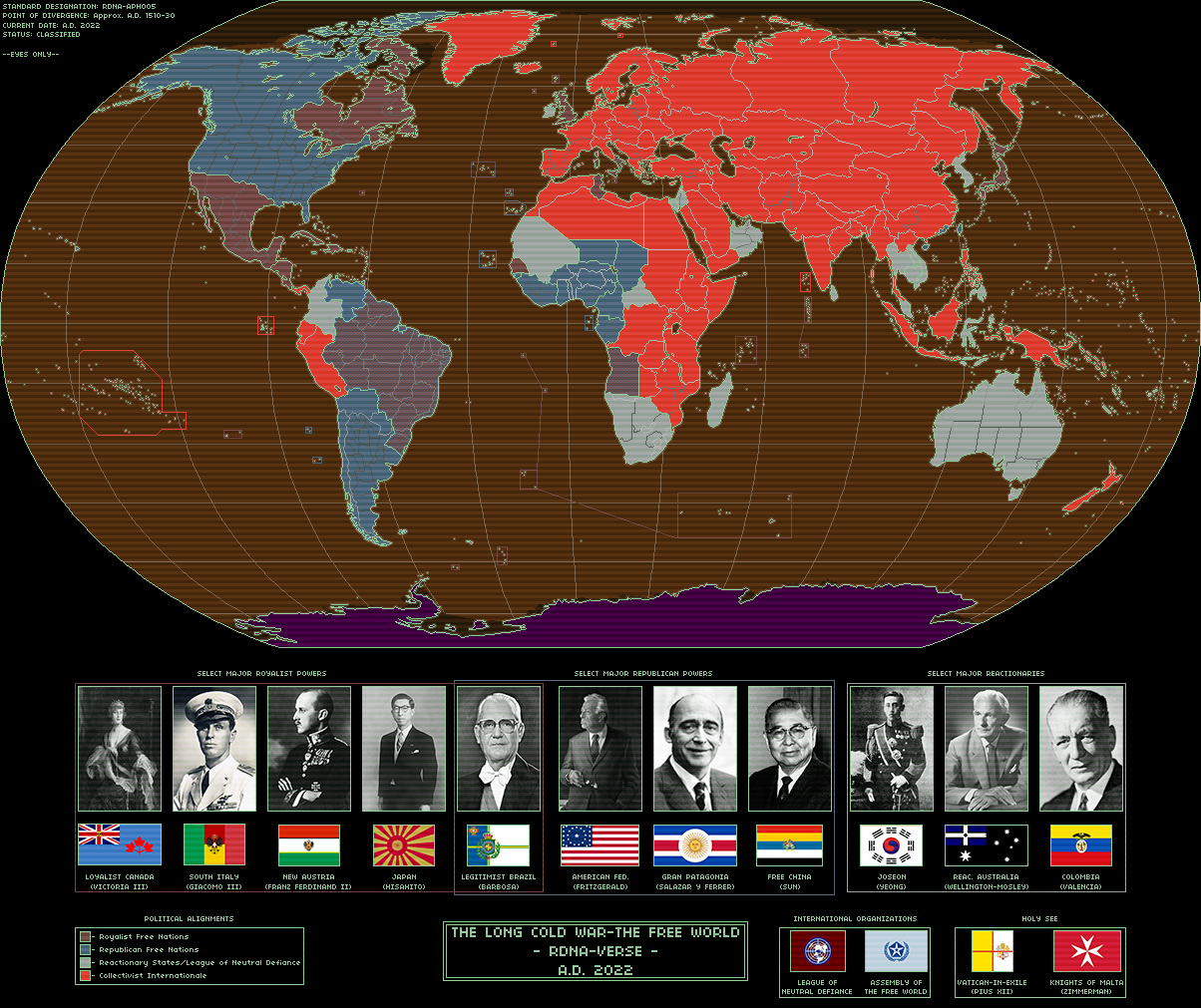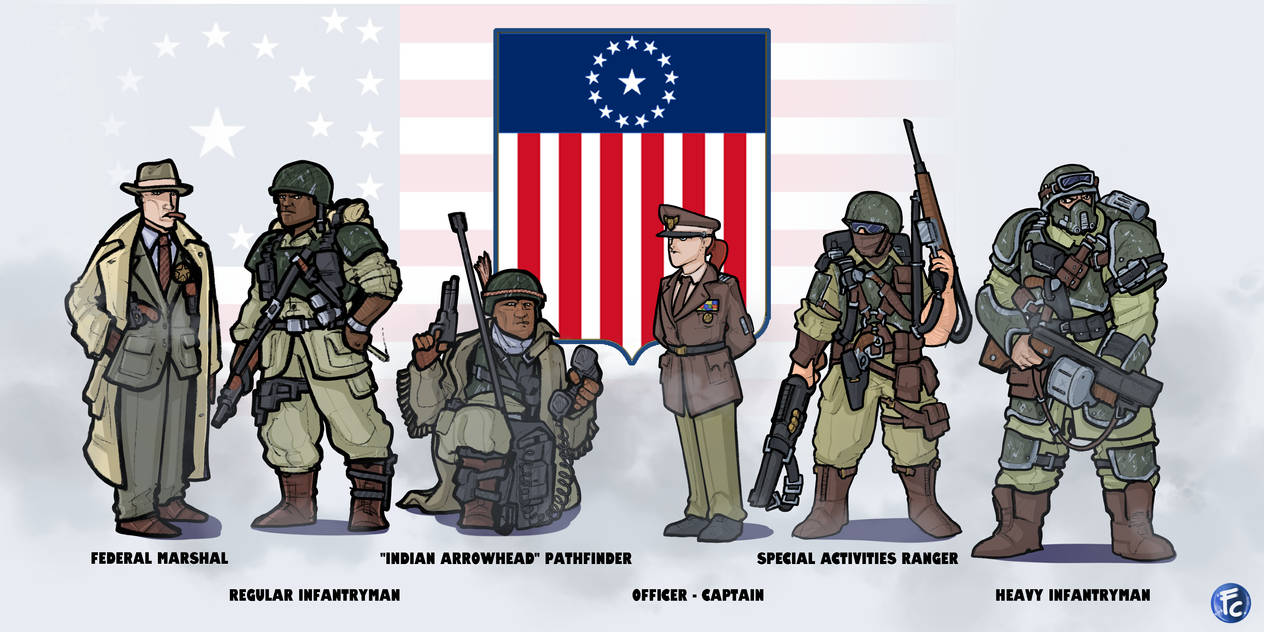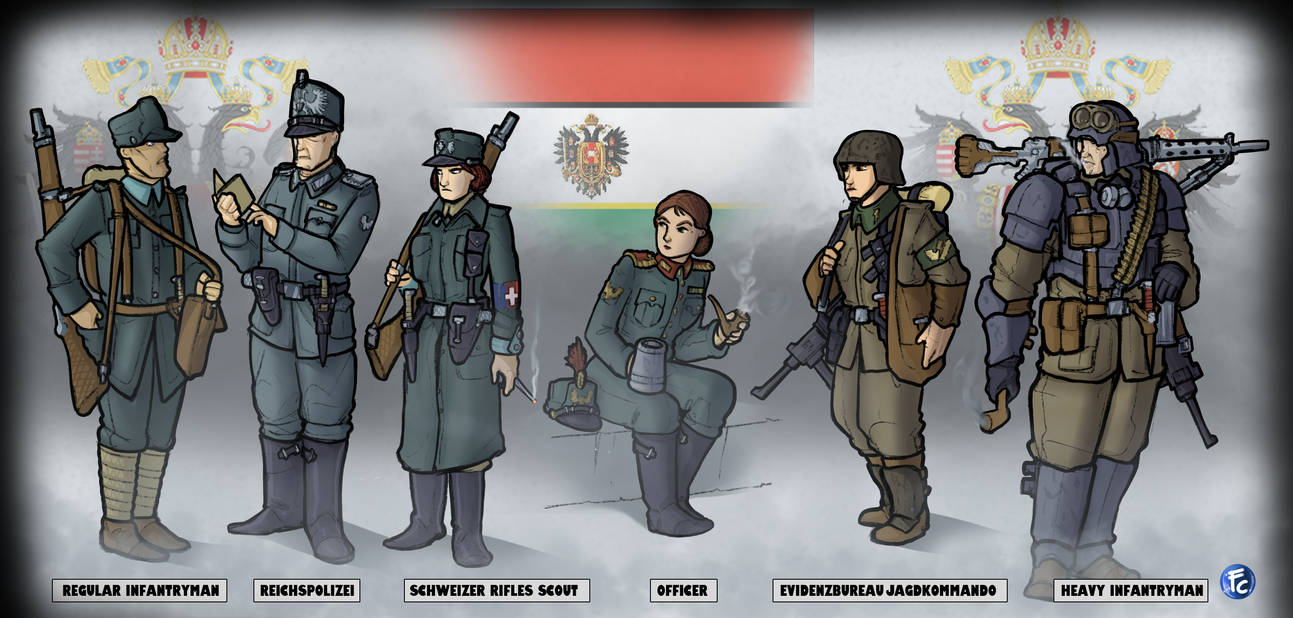South Italy: General Introduction
The Kingdom of South Italy holds the claim of being not only one of the last Free Nations of Europe, but also the last surviving monarchy on the Continent itself. While but a shadow of its former glory, its people are by no means weak or resigned to oblivion. The country's sheer stubbornness and nigh zealous fortress mentality, even in the face of the Collectivist Internationale, is such that it remains a royalist power in its own right.
Encompassing a defensible stretch of the Mediterranean centered around the so-called Mezzogiorno, the realm is a constitutional monarchy under the reign of King Giacomo III, the latest sovereign of the Savoia-Siracusa line. Though still claiming the pre-Terror borders from the early 20th Century, it is formally comprised of seven Crown Provinces, two Autonomous Territories and the "Special Protectorate" of Malta, all of which are represented in the
Parliamento Italiano. In practice, however, these have been supplemented by a system of "fortress-settlements" that emerged following the Napoli Reforms of 1930, with the even more fortified
Cittadella ("Citadels") having considerable leverage. Over time, the lines between the nobility, civil politicians and military have also blurred, to the point that regional commanders are almost akin to the feudal lords of old. While seen by some observers as an inevitable outcome to the country's generations-long fortress mentality, civil liberties remain firmly entrenched as have many social institutions. That being said, while the swan song of Reactionarism never truly took hold, the peculiar form of "democracy" as perceived here is militantly tinged. Service, especially in the
Regio Forze Armate Italiano (or "Royal Italian Armed Forces") grants greater rights to citizens out of the view that freedoms are earned, though equality under the law remains and no formal discrimination exists for those who choose not to for whatever reason.
The 38.8 million-strong populace themselves more than live up to their stringent standards. Officially, around 71% is Italian (many of at least partial Sicilian, Neapolitan or Sardinian lineage), with 22% being "Arabs" (catch-all for pure Arabs and those of Arab and Berber origin) and the remainder comprised of Greeks, Maltese and the unassimilated descendants of refugees from the Continent, notably the French. While relations between the two predominant groups especially had historically been terse, mutual hardship, common cause have over generations fostered a kind of camaraderie transcending differences, even while conserving said distinctions. Whether its the prevalence of Italian languages and Italo-Arabic (a creole blend derived from Tunisian Arabic), the growing trend of mixed-race relationships, these have also done much to further integrate the citizenry to an even greater extent than formal government policies. There are still some exceptions, particularly among some of the more old-fashioned Greeks, but such sentiments are nonetheless encapsulated in the phrase
Fratelli attraverso l'inferno ("Brothers through Hell"). In the face of the surrounding enemy, as a recurring anecdote puts it, all have their part to play.
Despite its difficult predicament, South Italy is neither alone nor insignificant. The expansive "No Man's Lands" that surround its borders (a grim legacy of Case Rubicon) are filled with mines, forts and hidden emplacements that have allowed the Italians to sustain nigh-constant skirmishes. The RFAI itself, which most citizens are part of one way or another, has over time gained a reputation for excelling at defense and being fearless even in the face of death, which has allowed the country to be an active component in maintaining the "Red Curtain." It's also more willing, however, to partake in more underhanded means to maintain an advantage, whether to fend off enemy scouting patrols or root out "traitors," false "refugees" and covert cells funded by the Internationale. This is not to ignore the significant aid provided by its ties with the "Three Crowns" of the New World, whether it be Royal Navy patrols helping keep the Mediterranean open or New Austrian military shipments and joint operations. To speak nothing of the realm's special protectorate: the Sovereign Knights of Malta. While unpredictable, showing more fealty to the Vatican-in-Exile than its actual benefactors, and notorious for a militant zeal even by the realm's standards, the last so-called "Crusader Kingdom" has nonetheless shown its commitment in blood multiple times.
Combined with a still-functional economy (with the wineries of Sicily and Calabria seen as among the best in the world), natalist policies and a substantial industrial base formed out of necessity, the country continues to succeed in holding the line against the Collectivists. That it has deterred them from fully conquering the Continent at all, however bloody the costs may be, speaks volumes of how its stubbornness is not unfounded. Nonetheless, its people know better than to be complacent. The enemy's efforts to isolate the realm and subvert it from within are known to have escalated in more recent years. Meanwhile, concerns have arisen over the growing social and mental costs of keeping up the fight with seemingly little hope for real respite.
Regardless, Italians are a resilient people. Everyone does their duty, be it for God, King or Fatherland. Or die trying.
Basic History of South Italy
The Italian Peninsula has seen much over the millennia. Here was where the glory that was Rome first emerged, as had its successors. It was here, as well, that the Renaissance took root, reviving the knowledge of Antiquity to enlighten a changing globe. The modern history of what would become South Italy, coincidentally, began around that time. For generations, and for a while after, there were various city-states, republics, duchies and kingdoms, most at the mercy of foreign powers in some form or another. Nonetheless, as Niccolò Machiavelli expressed in the 1530s, a sense of nationalism mirroring Ancient Greece had spread. This didn't happen overnight, however, as each state had their own ideas for what being "Italian" meant, whether in divided regions like Tuscany or the more united lands south of the Papal States under the Crowns of Naples and Sicily (colloquially known as the Mezzogiorno) and being more "patriotic" towards themselves than anything else.
A series of events over the next few centuries, from encroaching Habsburg influence in Venice to the wave of reforms that accompanied the so-called Enlightenment, gradually laid down the groundwork for bringing all of Italy together. The ascendant House of Savoia (which by the 17th Century had encompassed its namesake lands, as well as what had been Piedmont, Aosta, Genoa and Nissa) was involved in intermittent conflicts with the Spanish over their hegemony in the Mezzogiorno. This eventually led to Duke Vittorio Amedeo II, breaking away from French attempts to influence his realm, successfully establishing himself as King of Naples and Sicily in 1705. While this proved fleeting, as he was forced to relinquish the titles by his erstwhile Habsburg allies "to preserve order" in exchange for Corsica and Sardinia in 1723, the promise of genuine change compared to the stifling grip of the preceding feudal order laid the groundwork for not only widespread resentment, but growing support (as was increasingly elsewhere) for a more unified land.
It wasn't until the 1810s, however, that such trends would culminate in uprisings throughout much of the Peninsula. Figures like Giuseppe Mazzini and Daniele Manin came into prominence, espousing Italian patriotism and unity over division. Such people, who would be remembered in time as heroes, gained the attention of the Savoias through the reformist Duke Ferdinand (later King Ferdinand I). Seeing both a chance to elevate his dynasty's fortunes and to bring long-needed change to a fractured land, he and other nationalists embarked on what has since been known as the
Grande Risorgimento ("Great Resurgence"). Defined by both peaceful compromise and military force in the north, among the most notable successes was the "Mezzogiorno Revolution" in 1851, in which a Savoia-backed resistance force led by Vincenzo Fardella di Torrearsa and Giuseppe Garibaldi deposed the unpopular Bourbons who had assumed control. The 1854 Unification that followed formally proclaimed the Kingdom of the Two Italies. Although it wouldn't be until 1863 that the Papal States (and with it Rome) formally joined as the autonomous Vatican State, the Peninsula was effectively under one banner, to be ruled by and for Italians.
The latter parts of the 19th Century saw the realm struggling to both consolidate itself and bolster its prestige on the world stage. At first, this seemed almost Herculean, whether it was debates over Standard Italian, the introduction of republican-influenced constitutionalism or developing the more "backward" Mezzogiorno with greater financial and industrial incentives. Such hardships also contributed to the initial wave of Italians migrating to the New World to seek better fortunes (such as the American Federation), and may also have led to Ferdinand I marrying into Sicilian nobility (forging the House of Savoia-Siracusa). Nonetheless, with the help of both its Habsburg allies (through the Austro-Hungarian Crownlands) and the British Empire, it came to not only stand up on its own but expand beyond the Peninsula. By 1900, it had already established colonies in the former Ottoman territories of Tunisia and Tripolitania, as well as its "Special Protectorate" over the Sovereign Knights of Malta. It also gained considerable influence in the then-newly independent countries of Greece and Albania. Before long, the country was increasingly seen as a regional power in its own right.
Then, came the Terror. While stirrings of unrest were already occurring in parts of the country, for a time the Collectivists seemed far away. Nonetheless, Giacomo II ordered for various contingencies and plans to be drawn out should the worst come to pass. As the sheer extent and horror of the threat became all too evident, such efforts were soon put into action as the Continent crumbled, including the ironically named Case Elysium (aiding the retreat from the collapsing mainland that eventually led to the integration of Italian Greece in 1944). The most infamous of these, however, was Case Rubicon: a withdrawal done on a massive scale, through a combination of defensive lines and widespread scorched earth tactics. Callous as this was, and approved only with great reluctance by the monarch and upper ranks of the RFAI, this was seen as the most viable option to preserve the realm in any functional capacity, while leaving the enemy nothing to use against it. Thus, from the moment it was enacted in 1926, thousands of Italian soldiers and militia, along with several Knights, knowingly went to their deaths to deny the enemy their "victory" and seek vengeance for what was lost. Their sacrifices, however, not only gave the Papacy a chance to evacuate Rome before the Red tide consumed it, but also allowed the last major wave of refugees (whether from the fallen north or other so-called "Lost Nations" like France) to escape and bought the strained realm time to establish the final defensive perimeter from the provisional capital of Naples.
The Napoli Reforms signed in 1930 did more than simply rename the realm into the Kingdom of South Italy and sought to go beyond temporary measures in response to the new reality. Among the changes brought about were the codification of the fortress-settlement system, a policy of widespread conscription into the RFAI regardless of background, plans for a plebiscite for the Tunisian colonies and a commitment to stopping the enemy from closing the curtain on the Continent forever. In practice, all these largely formalized what was already occurring since the Terror, while the continuing threats posed by the enemy meant that the Reforms had to keep up with a volatile situation that could change at any moment. Indeed, Case Rubicon itself only came to its climactic if bloody end with the brutal Defense of Naples in 1937, when Collectivist forces launched a surprise attack on the Proto-Citadel. This would go down as the worst point in Italian history after the loss of Rome, as it led to the city itself being abandoned and destroyed "as Vesuvius brought ruin upon Pompeii," with the Savoia-Siracusas seeing no choice but to retreat to Palermo, where they rule to this day. It also marked the last time, however, that the defenses were breached to any significant degree. And while the skirmishes never truly ceased from then on, a sense of order was restored.
Subsequent years saw the Italians' fortress mentality further entrench itself into the national consciousness, with the notion of
fratelli attraverso l'inferno transcending ethnic, religious and even gender lines. As most readily volunteered themselves into either the military or civil work, by 1953 the policy of conscription morphed into offering greater rights to citizens through service. So it was, that even as a new feudal-style "aristocracy" emerged from the the bastions (with some commanders hailing from the old nobility), so too did new opportunities arise for even the lowliest commoner to become part of that elite. Yet regardless of where one is in society, as New Austrian and Loyalist Canadian observers noted during a joint exercise off Corsica in 1994, all are doing their part. That view, for all its grim ramifications, had proven itself as sturdy and in its own way, admirable as the people themselves.
They must be. For while emigration never ceased being open for those seeking a better life elsewhere, the loss of the Continent wholesale would not only risk shutting the Mediterranean off forever, but would also render the sacrifices of their forefathers to be all for nothing. The past century has proven them true, but for how long, who could truly say.
- "The World Almanac of Nations." American Federation. 2023 Edition.
----
For some added trivia, many of the "fortress-settlements" correspond to actual towns and cities across Italy, Tunisia and Greece. Meanwhile , placenames like "Candia" are the Italian forms of what would be in real life, cities like "
Heraklion."
The use of the term
Mezzogiorno (Italian for "Midday") in reference to Southern Italy is derived from how sunshine in that region is particularly strong around that time of day. While it's not clear when the word itself was first used for that part of the country, it's said to have gained popularity in real life after the 1860s, when it (then under the Kingdom of the Two Sicilies) became part of Italy.
The
Grande Risorgimento that led to the 1854 Unification is a direct nod to the real life
Risorgimento ("Resurgence") that eventually unified Italy by 1871. Coincidentally,
Mazzini,
Manin and
Garibaldi still played major roles in RDNA-verse version of events, though there's a more pronounced influence from the figures who, in our timeline, led the
Sicilian Revolution of 1848, such as Vincenzo Fardella di Torrearsa.
In real life, Southern Italy/Mezzogiorno never saw proper industrialization or development compared to the rest of the country after unification, which contributed to the notorious
"North-South Divide" and the proliferation of the Mafia. In the timeline, however, a combination of closer patronage from the House of Savoy (resulting eventually in the House of Savoia-Siracusa) and a more concerted effort to bring the region up to speed would go far in avoiding the malaise, while also laying the foundations for the country's transformation after the Terror.
The star icon used is the
Stella d'Italia ("Star of Italy"), which has been in use in various forms in the Italian Peninsula since Antiquity. While the one used to represent the "Citadels" are based on the
Italian Army's coat of arms.
The peculiarly militarized state of Italian society is a combination of various influences, from the feudalism that marked the
Kingdom of the Two Sicilies to pre-Fascist Italian constitutionalism and of all things,
Starship Troopers (the latter especially with the "service guarantees citizenship" undertones). The in-universe circumstances faced by the country have brought these about, as well as a sense of social camaraderie, largely out of necessity and the acceptance of having to fight on indefinitely. As the "perceived" alternative is destruction.
Case Rubicon is also a nod to the phrase "
Crossing the Rubicon." Originally a reference to Julius Caesar making his fateful choice to march into Rome, it notion of committing to a plan, to which there's no turning back.
